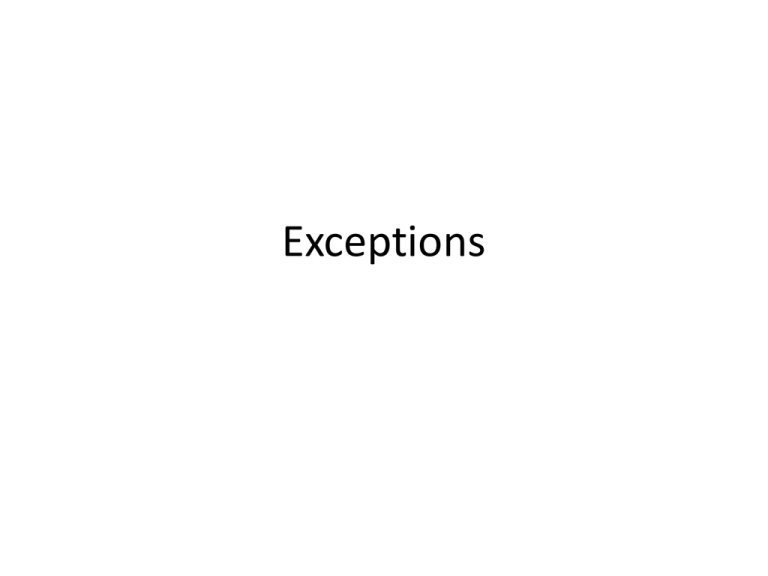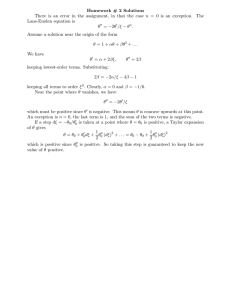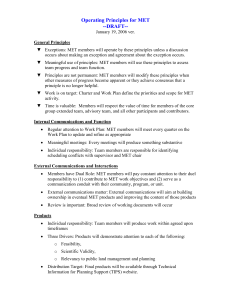Exceptions
advertisement

Exceptions
• Handling exceptions
• Exceptions are objects
– Subclasses of java.lang.Exception
– Checked and unchecked exceptions
• Exception propagation
• Handling multiple exceptions
• Throwing an exception
• Customized exception subclass
• Section 8.3 in Eck textbook
User enters data as a string. You need to convert to int value.
String s = ….
int i = Integer.parseInt( s);
Javadoc for parseInt method say it throws a NumberFormatException
Exceptions
• Exceptions are a way to signal an error.
• Exceptions extend from java.lang.Exception class.
• Common methods
– getMessage()
– printStackTrace()
• Checked exceptions must be declared in the method
declaration and must be handled.
– NumberFormatException, IOException
• Unchecked exceptions (extend from
java.lang.RuntimeException) do not.
– NullPointerException, IndexOutOfBoundsException
Exception Propagation
• You are writing a method B that calls another
method C that throws a checked exception.
• You must either handle the exception in your
method (try/catch) or
• You must declare that your method throws
the unhandled exception
– If method A calls method B, then A must handle
the exception or declare it.
Exception Propagation
OPTION 1
OPTION 2
public int convertToInt (String s) {
public int convertToInt (String s)
int i=0;
throws NumberFormatException {
try {
int i = Integer.parseInt( s);
i = Integer.parseInt( s);
return i;
} catch (NumberFormatException e) {
}
System.out.println( “User input invalid.”);
System.out.println( e.getMessage() );
e.printStackTrace();
}
return i;
}
Handling Multiple Exceptions
public int convertToInt (String[] s) {
int i=0;
try {
i = Integer.parseInt( s[1] );
} catch (NumberFormatException e) {
System.out.println( “User input invalid.”);
} catch (NullPointerException e) {
System.out.println(“ Program error.”);
} catch (IndexOutOfBoundsException e) {
System.out.println(“ Program error.”);
} catch (Exception e) {
System.out.println(“ Unknown error has occurred.”);
System.out.println(e.getMessage());
}
return i;
}
Order of catch
blocks is important.
The code will not work
correctly if this is first.
Throwing an exception
public double quadraticFormula (double a, double b, double c)
throws Exception {
double dis = b*b – 4.0*a*c;
if (dis < 0) {
Exception e = new Exception(“No real solution.”);
throw e;
} else {
double r = ( -b + Math.sqrt(dis)) / (2.0*a);
return r;
}
}
Creating an exception subclass
public class NoRealSolution extends Exception
{
private double d;
public double quadraticFormula (
double a, double b, double c)
throws NoRealSolution {
public NoRealSolution( double value ) {
super(“No Real Solution.”);
d = value;
}
double dis = b*b – 4.0*a*c;
if (dis < 0) {
NoRealSolution e =
new NoRealSolution(dis);
throw e;
} else {
public double getDiscriminatorValue() {
return d;
}
double r = ( -b + Math.sqrt(dis)) / (2.0*a);
return r;
}
}
}
Handling NoRealSolution Exception
double a, b, c;
try {
double r = x.quadraticFormula(a,b,c);
System.out.println (“ zero value is “+r);
} catch (NoRealSolution e) {
System.out.println(“No real roots. Discriminator is negative. “ + e.getDiscriminatorValue() );
}


